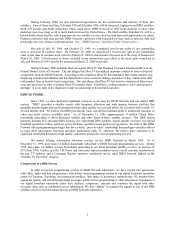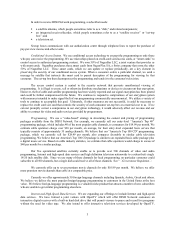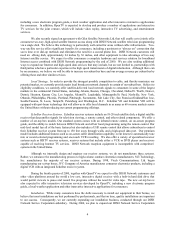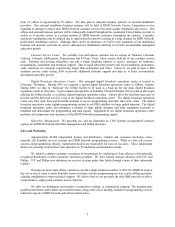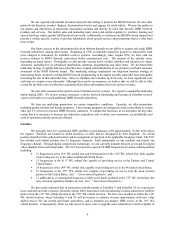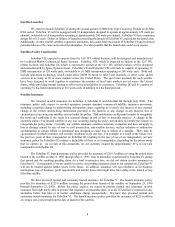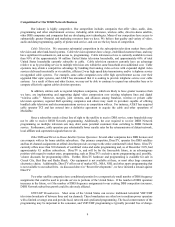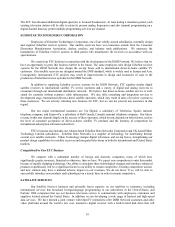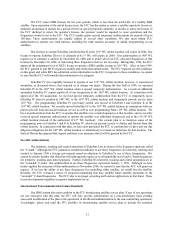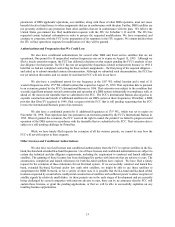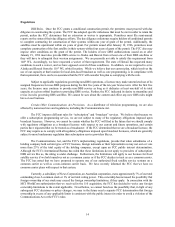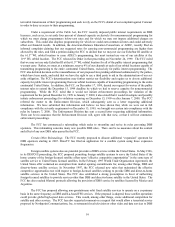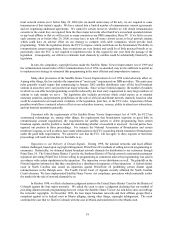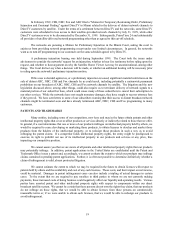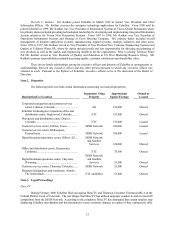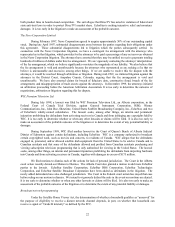Dish Network 1999 Annual Report Download - page 14
Download and view the complete annual report
Please find page 14 of the 1999 Dish Network annual report below. You can navigate through the pages in the report by either clicking on the pages listed below, or by using the keyword search tool below to find specific information within the annual report.12
The FCC issues DBS licenses for ten year periods, which is less than the useful life of a healthy DBS
satellite. Upon expiration of the initial license term, the FCC has the option to renew a satellite operator’s license or
authorize an operator to operate for a period of time on special temporary authority, or decline to renew the license. If
the FCC declined to renew the operator’s license, the operator would be required to cease operations and the
frequencies would revert to the FCC. The FCC usually grants special temporary authorizations for periods of up to
180 days. These authorizations are usually subject to several other conditions. We also must obtain FCC
authorization to operate our earth stations, including the earth stations necessary to uplink programming to our
satellites.
Our licenses to operate EchoStar I and EchoStar II at the 119° WL orbital location will expire in 2006. Our
license to operate EchoStar III over 11 channels at 61.5° WL will expire in 2008. Our authorization at 148° WL
requires us to construct a satellite by December 20, 2000 and to utilize all of our FCC-allocated frequencies at that
location by December 20, 2002, or risk losing those frequencies that we are not using. During May 1999, the FCC
approved the assignment to us of MCI’s license to operate a DBS satellite system at 110 ° WL. Also, in June 1999,
the FCC granted in part MCI’s request to modify and clarify that authorization. The FCC imposed several conditions
on this grant, and while MCI has submitted certain information to the FCC in response to these conditions, we cannot
be sure that the FCC will consider that submission to be adequate.
EchoStar IV was originally licensed to operate at our 119° WL orbital location, however, it experienced
anomalies, as discussed above, that required us to change our plans. During the first half of 1999, we operated
EchoStar IV at the 148° WL orbital location under a special temporary authorization. As a result of additional
anomalies EchoStar IV cannot exploit all of our frequencies at the 148° WL orbital location. In connection with
approval of the 110 acquisition, we received special temporary authorization from the FCC to temporarily move
EchoStar IV from its position at 148° WL to the 110° WL orbital location and temporarily provide service from
110° WL. The programming EchoStar IV previously carried was moved to EchoStar I and EchoStar II at the
119° WL orbital location. We recently moved EchoStar IV to the 119° WL orbital location in conjunction with our
plan to provide local-into-local broadcast service as well as core programming from 110° WL orbital location. We
have an authorization from the FCC to operate that satellite over certain frequencies at that location, and we recently
received special temporary authorization to operate the satellite over additional frequencies and at the 119.35° WL
orbital location (instead of the authorized 119.2° WL location). Our current plan is to transition some of the
programming now on EchoStar I and II to EchoStar IV, which can provide service to Alaska and Hawaii from that
orbital location. In connection with that plan, we have also petitioned the FCC to confirm that we have met our due
diligence obligations for the 148° WL orbital location, or alternatively to extend our milestone for that location. The
State of Hawaii has opposed that request and there is no assurance that it will be granted by the FCC.
In-orbit Authorizations
The telemetry, tracking and control operations of EchoStar I are in an area of the frequency spectrum called
the “C-band.” Although the FCC granted us conditional authority to use these frequencies for telemetry, tracking and
control, in January 1996 a foreign government raised an objection to EchoStar I’s use of these frequencies. We
cannot be certain whether that objection will subsequently require us to relinquish the use of such C-band frequencies
for telemetry, tracking and control purposes. Further, EchoStar II’s telemetry, tracking and control operations are in
the “extended” C-band. Our authorization to use these frequencies expired on January 1, 1999. Although we have
timely applied for extension of that authorization to November 2006, we cannot be sure that the FCC will grant our
request. If we lose the ability to use these frequencies for controlling either satellite, we would lose the satellite.
Recently, the FCC released a notice of proposed rulemaking that may prohibit future satellite operations in the
“extended” C-band frequencies. The FCC also is no longer accepting earth station applications in that band. These
recent developments might have negative implications for us.
International Telecommunication Union Standards
Our DBS system also must conform to the ITU broadcasting satellite service plan. If any of our operations
are not consistent with this plan, the ITU will only provide authorization on a non-interference basis pending
successful modification of the plan or the agreement of all affected administrations to the non-conforming operations.
Accordingly, unless and until the ITU modifies its broadcasting satellite service plan to include the technical


